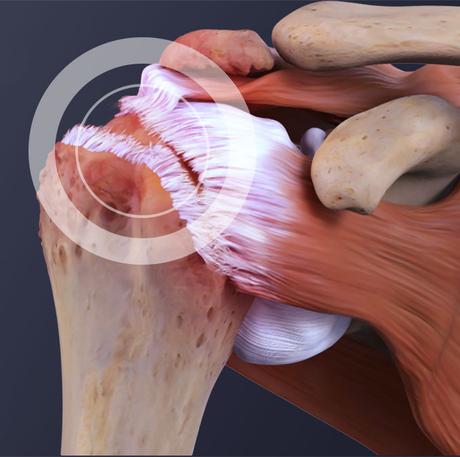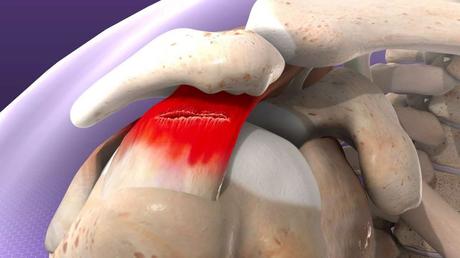Shoulder impingement syndrome is a common injury in which the shoulder bursa or tendons that move the shoulder or the rotator cuff repeatedly get stuck and are pressed when raising the arm vertically. Shoulder impingement can be very painful.
Persistent shoulder impingement can cause shoulder bursitis (inflammation of the joint sacs), structural damage to the rotator cuff tendons, rotator cuff tears, or rotator cuff tendonitis.
The first result of these injuries is that it becomes painful to move the shoulder, but there is also a possibility of a significant weakening of the shoulder function and a complete tear of the rotator cuff tendon.

Where Is the Shoulder Impingement Area?
The shoulder impingement area is between the head of the humerus (the ball-shaped shoulder bone) and the top of the scapula (known as the acromion).
When the shoulder is functioning normally, the movement of the lever appendage of the scapula should not affect the underlying soft bursa or rotator cuff tendons.
But when shoulder muscles are weak or uncoordinated, shoulder movement patterns can become abnormal, and shoulder impingement can occur.
The First Sign of Shoulder Impingement Is often a Simple Clicking Sound on the Shoulder.
Over time, these minor jams turn into painful clicks that reduce the shoulder’s mobility and eventually cause it to lose function. When impingement occurs, the shoulder bursa is repeatedly pressed and swollen, and the problem of shoulder bursitis occurs.
Likewise, repeated entrapment of the rotator cuff tendon may lead to rotator cuff tendonitis. In severe cases, the shoulder muscles are torn. All these injuries may occur together or separately.

How Do You Know If You Have Shoulder Impingement?
Common symptoms of shoulder impingement include:
- Shoulder pain or clicking when you reach behind your head or back.
- Pain when you try to grab the seat belt or pull it across your chest.
- Shoulder pain when you raise your arm to shoulder height or when you raise your arm above your head.
- Pain when lying on the affected shoulder.
- The shoulder may be painful even while resting and standing when the injury becomes more severe.
- Muscle weakness or muscle pain when you try to pick up or lift something.
What Is The Best Test for Shoulder Drop?
Shoulder impingement is usually diagnosed by a qualified physician or physical therapist during a clinical examination. They perform a series of special shoulder impingement tests to determine the presence or absence of this injury. They also check the shoulder’s range of motion, the rotator cuff muscles’ strength, the scapula’s effect on impingement, and other related tests.
Ultrasound Imaging in Real-Time (in the moment)
An ultrasound scan is relatively inexpensive and is a practical diagnostic test to depict changes and progression of shoulder impingement and detect any associated injuries, such as shoulder bursitis, rotator cuff tears, calcific tendonitis, or shoulder tendinopathy. When performing an ultrasound scan in real-time, the person performing the ultrasound or the radiologist can observe the position of the shoulder as it moves through the area of impingement.
Does MRI Show Shoulder Impingement?
Impingement of the shoulder is unlikely to be detected on MRI. MRI is a static test that cannot correctly image the shoulder impingement, such as with your arm at your side. MRI may show rotator cuff tears or bursitis but not dynamic entrapment.
X-Ray
X-ray does not show entrapment, but it can show space reduction under the occipital appendage due to the presence of bone spurs. Consult your doctor about the most appropriate diagnostic and clinical tests.

What Causes Shoulder Impingement?
While an acute injury such as a fall can occur and cause this injury, impingement of the rotator cuff/bursa on the outer edge of the scapula (acromion) is more likely to occur due to repeated motions of the arm in the impingement area.
Postures that significantly narrow the area below the axillary appendage include the following:
- When the arm is placed directly above the head
- When the arms are raised and moved to shoulder height or close to it
- Humping and putting the shoulders forward
The tendons of the shoulder abductor muscles are protected by bones (essentially the acromion) and ligaments that form a protective arch over the shoulder. Still, they do not prevent the shoulder from being injured.
These injuries include shoulder bursitis, moderate tendon swelling (rotator cuff tendonitis), calcified tendinopathy (a bone formation within the tendon), and complete or partial rotator cuff tendon tears may require surgery.
What Is The Best Treatment for Shoulder Impingement?
Many different structures may be injured by shoulder rotator impingement, and each may require a different treatment method. Understanding the cause of the impingement in the first place is the most crucial step to healing the injury in the short term and preventing the shoulder from impinging again in the long term. On the other hand, frequent shoulder impingement can expose you to the risk of tearing the shoulder muscles and eventually lead you to surgery. Because shoulder impingement injuries and treatment options can vary significantly, it’s essential to see a healthcare professional specializing in shoulder injuries.
A General Guide to Treating Shoulder Impingement
Researchers have concluded that seven steps must be covered to rehabilitate these injuries and prevent re-injury.
These steps are:
- The initial stage of injury: protection, pain relief, and treatment with anti-inflammatory drugs and physiotherapy
- Regain full shoulder range of motion
- Recovery of shoulder control power and shoulder joint movement levels
- Restoring the normal functions of the shoulder, spine, shoulder, neck
- Restoring the strength of the shoulder muscles
- Exercises to reach previous speed, strength, depth, and agility
- Resuming exercise or work
In What Cases Is Corticosteroid Injection Effective?
Corticosteroid injections may help reduce pain in the early stages when there is severe inflammation and bursitis of the shoulder. It is essential to mention that when the pain of shoulder bursitis subsides, to make sure that the shoulder stiffness does not return when the effect of the injection wears off, the strength and flexibility of the shoulder joint and its involvement with the spine of the back of the chest, neck and the way the joint moves Shoulders should be examined. If shoulder mobility is not addressed, shoulder impingement is likely to reoccur, or the problem may progress to tendinopathy or a tear of the shoulder rotator muscles.
Who Suffers from Shoulder Impingement Syndrome?
Impingement syndrome is more common in those who engage in physical activities that require the arm to be raised frequently, such as tennis, golf, swimming, weightlifting, or throwing a ball. Occupations that require repeated lifting of the arm above the head or working with the hands while the hands are at shoulder height or higher expose most people to shoulder rotator cuff injuries.
Physiotherapy for Shoulder Impingement Injury
Determining the status of your injury during rehabilitation and physiotherapy depends on many factors and is done by the physiotherapist during clinical examinations. You will find that, in many cases, as your function improves and test results improve, your physical therapist will continue to advance the rehabilitation process. It is also important to note that progression from one stage to another should be under the close supervision of a professional because moving to the next level of rehabilitation, if premature, may lead to re-injury and discomfort for the patient.

